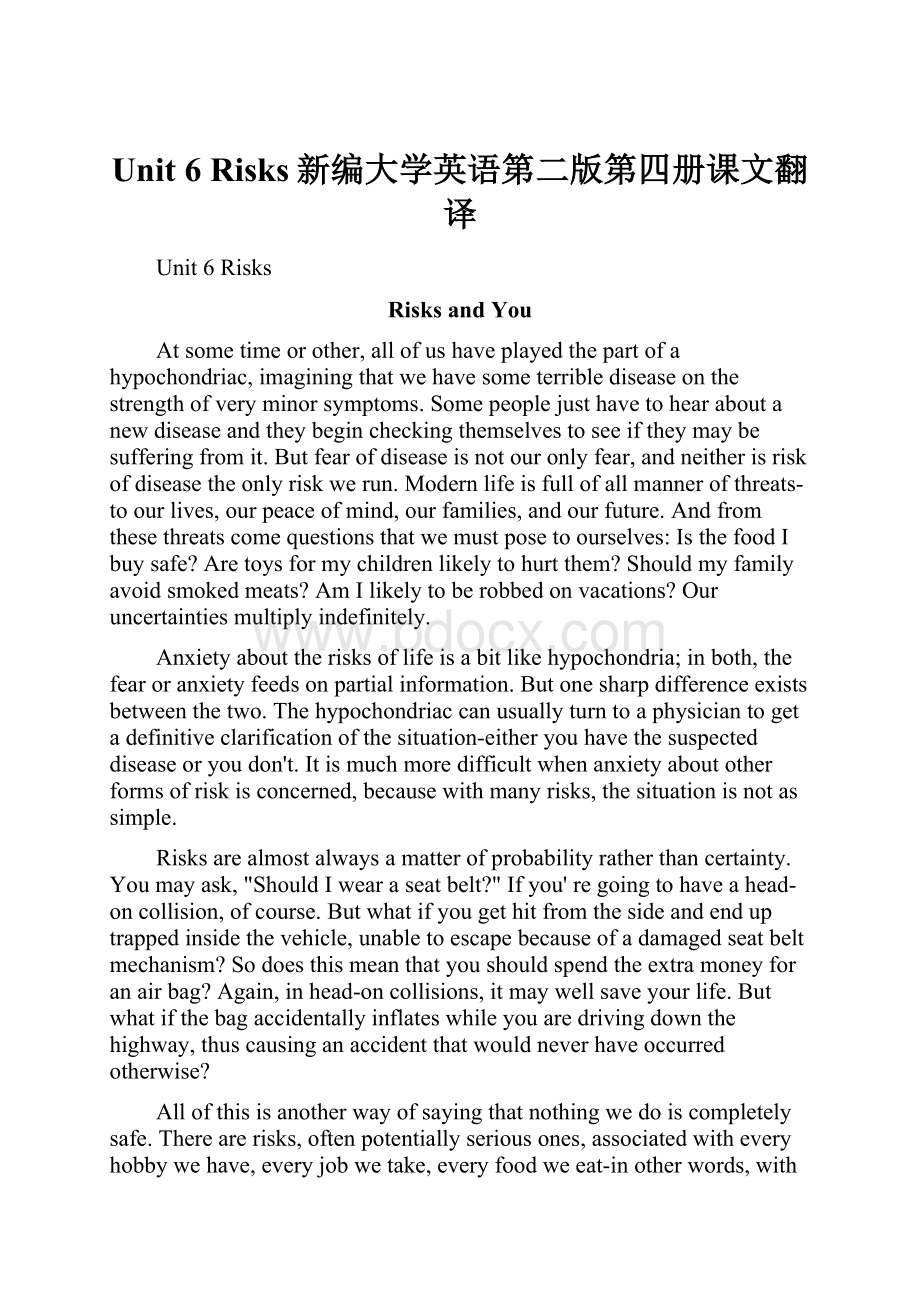 Unit 6 Risks新编大学英语第二版第四册课文翻译.docx
Unit 6 Risks新编大学英语第二版第四册课文翻译.docx
- 文档编号:25107368
- 上传时间:2023-06-05
- 格式:DOCX
- 页数:13
- 大小:28.98KB
Unit 6 Risks新编大学英语第二版第四册课文翻译.docx
《Unit 6 Risks新编大学英语第二版第四册课文翻译.docx》由会员分享,可在线阅读,更多相关《Unit 6 Risks新编大学英语第二版第四册课文翻译.docx(13页珍藏版)》请在冰豆网上搜索。

Unit6Risks新编大学英语第二版第四册课文翻译
Unit6Risks
RisksandYou
Atsometimeorother,allofushaveplayedthepartofahypochondriac,imaginingthatwehavesometerriblediseaseonthestrengthofveryminorsymptoms.Somepeoplejusthavetohearaboutanewdiseaseandtheybegincheckingthemselvestoseeiftheymaybesufferingfromit.Butfearofdiseaseisnotouronlyfear,andneitherisriskofdiseasetheonlyriskwerun.Modernlifeisfullofallmannerofthreats-toourlives,ourpeaceofmind,ourfamilies,andourfuture.Andfromthesethreatscomequestionsthatwemustposetoourselves:
IsthefoodIbuysafe?
Aretoysformychildrenlikelytohurtthem?
Shouldmyfamilyavoidsmokedmeats?
AmIlikelytoberobbedonvacations?
Ouruncertaintiesmultiplyindefinitely.
Anxietyabouttherisksoflifeisabitlikehypochondria;inboth,thefearoranxietyfeedsonpartialinformation.Butonesharpdifferenceexistsbetweenthetwo.Thehypochondriaccanusuallyturntoaphysiciantogetadefinitiveclarificationofthesituation-eitheryouhavethesuspecteddiseaseoryoudon't.Itismuchmoredifficultwhenanxietyaboutotherformsofriskisconcerned,becausewithmanyrisks,thesituationisnotassimple.
Risksarealmostalwaysamatterofprobabilityratherthancertainty.Youmayask,"ShouldIwearaseatbelt?
"Ifyou'regoingtohaveahead-oncollision,ofcourse.Butwhatifyougethitfromthesideandenduptrappedinsidethevehicle,unabletoescapebecauseofadamagedseatbeltmechanism?
Sodoesthismeanthatyoushouldspendtheextramoneyforanairbag?
Again,inhead-oncollisions,itmaywellsaveyourlife.Butwhatifthebagaccidentallyinflateswhileyouaredrivingdownthehighway,thuscausinganaccidentthatwouldneverhaveoccurredotherwise?
Allofthisisanotherwayofsayingthatnothingwedoiscompletelysafe.Therearerisks,oftenpotentiallyseriousones,associatedwitheveryhobbywehave,everyjobwetake,everyfoodweeat-inotherwords,witheveryaction.Butthefactthattherearerisksassociatedwitheverythingwearegoingtododoesnot,orshouldnot,reduceustotremblingneurotics.Someactionsareriskierthanothers.Thepointistoinformourselvesabouttherelevantrisksandthenactaccordingly.
Forexample,largercarsaregenerallysaferthansmallonesincollisions.Buthowmuchsafer?
Theansweristhatyouareroughlytwiceaslikelytodieinaseriouscrashina
smallcarthaninalargeone.Yetlargercarsgenerallycostmorethansmallones(andalsousemoregas,thusincreasingtheenvironmentalrisks!
),sohowdowedecidewhenthereducedrisksareworththeaddedcosts?
Theultimateriskavoidermight,forinstance,buyatankoranarmoredcar,thusminimizingtheriskofdeathorinjuryinacollision.Butistheaddedcostandinconvenienceworththedifferenceinprice,evensupposingyoucouldaffordit?
Wecannotbegintoanswersuchquestionsuntilwehaveafeelforthelevelofrisksinquestion.Sohowdowemeasurethelevelofarisk?
Somepeopleseemtothinkthattheanswerisasimplenumber.Weknow,forinstance,thatabout25,000peopleperyeardieinautomobileaccidents.Bycontrast,onlyabout300dieperyearinmineaccidentsanddisasters.Doesthatmeanthatridinginacarismuchriskierthanmining?
Notnecessarily.Thefactisthatsome200millionAmericansregularlyrideinautomobilesintheUnitedStateseveryyear;perhaps700,000areinvolvedinmining.Therelevantfigurethatweneedtoassessariskisaratioorfraction.Thenumeratorofthefractiontellsushowmanypeoplewerekilledorharmedastheresultofaparticularactivityoveracertainperiodoftime;thedenominatortellsushowmanypeoplewereinvolvedinthatactivityduringthattime.Allrisklevelsarethusratiosorfractions,withvaluesbetween0(norisk)and1(totallyrisky).
Byreducingallriskstoratiosorfractionsofthissort,wecanbegintocomparedifferentsortsofrisks-likeminingversusridinginacar.Thelargerthisratio,thatis,thecloseritisto1,theriskiertheactivityinquestion.Inthecasejustdiscussed,wewouldfindtherelativesafetyofcartravelandcoalminingbydividingthenumbersofliveslostineachbythenumberofpeopleparticipatingineach.Here,itisclearthattheriskinessoftravelingbycarisabout1deathper10,000passengers;withmining,therisklevelisabout4deathsper10,000miners.Soalthoughfarmorepeoplearekilledincaraccidentsthaninmining,thelatterturnsouttobefourtimesriskierthantheformer.Thoseratiosenableustocomparetherisksofactivitiesorsituationsasdifferentasapplesandoranges.Ifyouareopposedtorisks,youwillwanttochooseyouractivitiesbyfocusingonthesmall-ratioexposures.Ifyouarereckless,thenyouarenotlikelytobeafraidofhigherratiosunlesstheygetuncomfortablylarge.
Onceweunderstandthatriskcanneverbetotallyeliminatedfromanysituationandthat,therefore,nothingiscompletelysafe,wewillthenseethattheissueisnotoneofavoidingrisksaltogetherbutratheroneofmanagingrisksinasensibleway.Riskmanagementrequirestwothings:
commonsenseandinformationaboutthecharacteranddegreeoftheriskswemayberunning.
风险与你
1在说不定的某个时候,我们大家都曾充当过疑病症患者的角色,只凭一些轻微的症状便怀疑自己得了某种可怕的病。
有的人只要一听说一种新的疾病,就会去检查,看自己是否可能患了这种病。
然而,对疾病的恐惧并非我们唯一的恐惧。
同样,患病的危险也并非我们唯一会遇上的危险。
现代生活中充满了各种各样的威胁,诸如对我们生命的威胁,对我们平和心境的威胁,对我们家人的威胁,对我们未来的威胁。
从而产生了好些问题,我们不得不问自己:
我买的食品安全吗?
给孩子们的玩具会伤害他们吗?
我们家的人是不是不该吃熏肉?
我度假时会不会遭抢劫?
我们的疑虑就无休止地增加。
2对生活中风险的担忧与疑病症有相似之处;二者的恐惧或忧虑皆起因于信息不全面。
但二者之间也存在一个明显的差别。
疑病症患者通常可以求助于医生,以便澄清疑虑——要么你得了你所怀疑的疾病,要么你没得。
但当涉及到其它形式的风险时,事情就要困难得多,因为对许多风险来说,情况并不那么简单。
3风险几乎总是一个可能性的问题而无确定性可言。
你也许会问:
“我该不该系安全带?
”如果你坐的车要与其它车正面相撞,那当然该系安全带。
倘若你的车侧面被撞,结果你被困在车里,又因安全带装置遭破坏而无法挣脱,那怎么办呢?
这是否意味着你该再花些钱在车内安一个保险气袋呢?
同样,在正面相撞的情况下,保险气袋完全可以救你一命。
但是,万一正当你在高速公路上开车时,保险气袋突然意外充气膨胀,从而导致了本来绝不会发生的事故,那又该如何是好?
4上面说的这一切,只是从另一角度说明我们所做的事没有一件是百分之百安全的。
有些风险——常常是潜在的重大风险——与我们的每个业余爱好、所做的每项工作、所吃的每种食物有关,换句话说,与所进行的任何活动有关。
但我们又不能,也不该因危险存在于我们将要做的每件事,而变成战战兢兢的神经症患者。
有些活动是比其它活动更危险。
关键在于要让自己了解相应的风险,然后相机行事。
5例如,两车相撞时,大车总的说来要比小车安全些。
可究竟能安全多少呢?
答案是这样:
在一起严重的车祸中坐小车丧生的可能性是坐大车的两倍左右。
然而,大车通常比小车贵(并且消耗更多的汽油,由此给环境带来了更大的风险!
)。
那么我们该怎样确定什么时候值得为降低风险增加花费呢?
例如,避免风险最保险的做法也许是去买一辆坦克或装甲车,从而把撞车时死亡或受伤的风险降到最小。
然而,即便你买得起,这笔额外的费用以及忍受坦克或装甲车所带来的不便是否值得呢?
6在我们尚不知所涉及的风险程度之前,我们还无法回答这些问题。
那么,我们该如何去衡量风险程度呢?
有些人似乎认为答案只不过是一个简单的数字。
例如,我们知道每年大约有25,000人死于车祸。
相比之下,每年只有大约300人死于矿山事故和灾难。
这难道就意味着乘坐汽车要比采矿危险得多吗?
未必。
事实是,在美国每年大约有两亿人经常性地以车代步;而大概只有70万人从事采矿作业。
我们评估一种风险时,所需要的有关数字是一个比率或分数。
该分数的分子告诉我们在某个特定时期由于从事某种特定活动而丧生或受伤的人数;其分母告诉我们在这一时期从事这种活动的总人数。
这样,所有的风险程度都是由比率或分数表示,其大小介于0(无风险)到1(完全风险)之间。
7通过把所有风险都简化为这种比率或分数,我们便可以开始比较不同种类的风险,如比较采矿与乘坐汽车。
这个比率越大,也就是说它越接近1,那么有关活动的风险就越大。
在刚才讨论的例子中,我们可以用每一活动中死亡的人数除以参与该活动的总人数,从而找出汽车旅行与采煤的相对安全性。
此处,我们可以很清楚地看到,乘坐汽车旅行的风险是每一万人中大约有一人丧生;而就采矿而言,其危险程度是每一万矿工中大约有四人死亡。
所以,尽管在车祸中丧生的人远比采矿要多,其实后者的风险是前者的四倍。
这些比率使我们能够对毫不相干的活动或情形的危险性加以比较,即便差别如苹果与橘子那样大也能比较。
如果你反对冒险,你就会选择风险比率较小的活动。
如果你无所畏惧,那么你往往会对高比率不太在乎,除非它们大得令人难以承受。
8我们一旦明白了风险是永远无法从任何情况中完全去除的,因而就没有绝对安全的事,我们也就会明白问题的关键不是要彻底避免风险,而是要理智地管理风险。
风险管理需要两大要素:
常识以及与我们可能要承担的风险的性质和程度相关的信息。
HealthRisks
OpinionpollsrepeatedlytellusthattheonlythingAmericansworryaboutmorethantheenvironmentistheirhealth.Thisisentirelyunderstandable,forhealthisobviouslypreferabletoillness.Whatmakestoday'spreoccupationwithhealthslightlysurprisingisthatAmericansarefarhealthiernowthantheyhaveeverbeen.Manydiseasesthatoncestruckterrorintoheartshaveeitherbeencompletelyeliminatedorbroughtundercontrol.AlthoughAIDSisanotableexception,fewnewmasskillershavecomealongtoreplacetheonesthathavebeeneliminated.
Nonetheless,health—andthevariousthreatstoit—remainseveryone'spermanentconcern.Afterall,morethanhalfofus(57percent)willdiefromeitherheartdiseaseorcancer,ifcurrenttrendscontinue.
Onemajorproblemwithanycomparisonofhealthrisks—especiallylife-threateningones—isthattheydifferenormouslyintheirimmediacy.Forinstance,AIDS—ifyougetit—willprobablybefatalafteranumberofyears.Cancerinducedbysmokingorexposuretoradiation,ontheotherhand,maytake20to30yearsbeforeitscatastrophiceffectsshowup.Inmakingchoicesabouthealthrisks,therefore,itisimportanttobearinmindthelikelytimelagbetweentakingariskandsufferingitsconsequences.
Thosewithamindto"livefortoday"areapttobeindifferenttohealthrisksthathaveaverylongincubationperiod.Althoughthisisshort-sighted,itdoesmakesensetodiscountlong-termrisksmorethanshort-termones.Afterall,whenvirtuallyanyofusisconfrontedwiththechoiceofdoingsomethinglikelytokillustodayversusdoingsomethinglikelytokillusintwodecades,thechoiceisgoingtobethelesserofthetwoevils.
Onecommonlyusedmeasuretodealwithsuchproblemsisaconceptcalledyearsofpotentiallifelost(YPLL).Theideaisthatfora25-year-old,doingsomethingthatwillkillhimin5yearsismuchmore"costly"thandoingsomethingthatwillkillhimin40years.Bothmayinvolvethesameelementofrisk—thesameprobabilityofeventuallydyingfromthatactivity—butariskthatmaycauseimmediatedamageismuchmorecostlythanoneforwhichthepiperneedn'tbepaidforalongtime.Inthefirstcase,hewillhavehisnormallifespancutshortbyabout45years;inthelattercase,thedeficitisabout5years.Thinkingaboutmattersinthislightinevitablycausesareassessmentofmanyofthethreatstohealth.Forinstance,heartdiseaseisthesinglelargestkillerofAmericans,wayinfrontofcancerorstrokes.However,heartdiseasetendstostriketheelderlyinmuchgreaterproportionsthanyoungerpeople.Cancer,bycontrast,killsfewerpeoplebuttendstostrikesomewhatearlierth
- 配套讲稿:
如PPT文件的首页显示word图标,表示该PPT已包含配套word讲稿。双击word图标可打开word文档。
- 特殊限制:
部分文档作品中含有的国旗、国徽等图片,仅作为作品整体效果示例展示,禁止商用。设计者仅对作品中独创性部分享有著作权。
- 关 键 词:
- Unit Risks新编大学英语第二版第四册课文翻译 Risks 新编 大学 英语 第二 第四 课文 翻译
 冰豆网所有资源均是用户自行上传分享,仅供网友学习交流,未经上传用户书面授权,请勿作他用。
冰豆网所有资源均是用户自行上传分享,仅供网友学习交流,未经上传用户书面授权,请勿作他用。


 《初级会计实务》试题题库大全及答案详解.docx
《初级会计实务》试题题库大全及答案详解.docx
